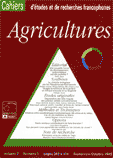Principaux virus du niébé ("Vigna unguiculata" L. Walp) au Togo
Résumé
Surveys were conducted in various cowpea-producing areas of Togo to detect major cowpea viruses and identify cowpea varieties resistant to these viruses. Antisera reacting with the six major cowpea viruses, and the chemicals required for the serological tests, were obtained from the Virology Unit of the International Institute of Tropical Agriculture (IITA, Ibadan, Nigeria). All plants were grown and maintained in insect-proof cages. Both cultivated fields and experimental plots in major cowpea-producing areas of Togo were surveyed, and trifoliate leaves from plants showing viral symptoms (mosaic, mottling) were collected. Samples were also obtained from weeds or fodder plants. Serological tests (double diffusion in agarose gel and DAS-ELISA) were used for identifying the viruses. From the 705 field samples examined, 63.12 % reacted positively to at least one of the six cowpea virus antisera studied. The following cowpea viruses were identified : cowpea aphid-borne mosaic virus (CAMV), cowpea mottle virus (CMeV), cowpea mosaic virus (CPMV), the southern bean mosaic virus (SBMV), cowpea mild mottle virus (CMMV) and the cowpea strain of tobacco mosaic virus (TMV-CS). CPMV was the most widespread of the six viruses. Mixed infections were often recorded involving two or more viruses. Various wild plants were found to be infected with five of these six cowpea viruses, these included : Cassia hirsuta (SBMV) Centrosema pubescens (CMMV), Nauclea latifolia (CMMV, CAMV) and Mucuna Sp. (TMV-CS). Cowpea cultivars were mechanically inoculated and screened, using cloned isolates of three isometric cowpea viruses : cowpea mottle virus (CMeV), cowpea mosaic virus (CPMV) and southern bean mosaic virus (SBMV). Symptoms were scored between seven and thirty days after inoculation by assessing the number of infected plants and the intensity of symptoms on a scale basis (1 \= no symptom and 5 \= severe symptoms). Using cloned isolates of CMeV, CPMV and SBMV, several cowpea cultivars, including TVx 1850-01E, IT82E-16, IT83S-818, IT81D-1007, 58-146, IT82D-703, IT82D-786, TVx 3236-01G, were found to be resistant to at least one of these viral isolates.Téléchargements
Publié
1993-09-01
Comment citer
Yawovi, M., & Gumedzoe, D. (1993). Principaux virus du niébé ("Vigna unguiculata" L. Walp) au Togo. Cahiers Agricultures, 2(5), 352–355 (1). Consulté à l’adresse https://revues.cirad.fr/index.php/cahiers-agricultures/article/view/29809
Numéro
Rubrique
Articles

